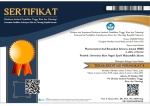Kajian Mutu Produk Tablet Metformin Hidroklorida Extended-Release yang Dipasarkan di Indonesia
Abstract
Some metformin hydrochloride extended-release (MetHCl-XR) tablet products have been marketed in Indonesia with varying prices. In general, price is considered to indicates the quality of a product. This research was conducted to review the products quality, especially the dissolution rate of the products, and to find out if the price is an indicator of the product quality. Three brands of MetHCl 500 mg XR tablets were randomly selected, namely Tablet A, B, and C which the price of Tablet B > A > C, then the Tablets were characterized. The results showed that Tablet A, B, and C contain MetHCl with an average of 100.61%, 98.72%, and 101.15% respectively, and met the uniformity of dosage unit requirement. Tablet A met the requirements of dissolution tests 1, 2, 3, and 4, while Tablet B and C met the requirements of dissolution tests 1 and 3. The cumulative percentage of MetHCl release at the 10th hour of Tablet A, B, and C were 94.18%, 97.24%, and 94.59% respectively with the release kinetics of Tablet A and B following Higuchi model, whereas Tablet C following a first-order. Drug release of all tablets occurred in non-Fick diffusion. In conclusion, the three tablets met the standards required by USP 43 and the price is not an indicator of MetHCl-XR tablet products quality.
Keywords
References
Dange, Y.D. et al. (2017) “Development and Validation of UV-Spectrophotometric Method for Estimation of Metformin in Bulk and Tablet Dosage Form,” Indian Journal of Pharmaceutical Education and Research, 51(4s), pp. s754–s760. doi:10.5530/ijper.51.4s.109.
Farmakope Indonesia. VI (2020). Jakarta: Kementrian Kesehatan Republik Indonesia.
Lisik, A. and Musiał, W. (2019) “Conductomeric Evaluation of the Release Kinetics of Active Substances from Pharmaceutical Preparations Containing Iron Ions,” Materials, 12(5), p. 730. doi:10.3390/ma12050730.
Moosavi, S.M. and Ghassabian, S. (2018) “Linearity of Calibration Curves for Analytical Methods: A Review of Criteria for Assessment of Method Reliability,” in Calibration and Validation of Analytical Methods - A Sampling of Current Approaches. InTech. doi:10.5772/intechopen.72932.
Paarakh, M.P. et al. (2018) “Release Kinetics - Concepts and Applications,” International Journal of Pharmacy Research & Technology, 8.
Sanchez-Rangel, E. and Inzucchi, S.E. (2017) “Metformin: clinical use in type 2 diabetes,” Diabetologia, 60(9), pp. 1586–1593. doi:10.1007/s00125-017-4336-x.
The United States Pharmacopeia. 43rd edn (2020a). Rockville: The United States Pharmacopeial Convention.
The United States Pharmacopeia. 43rd edn (2020b). Rockville: The United States Pharmacopeial Convention.
Wadher, K., Umekar, M. and Kakde, R. (2011) “Formulation and evaluation of a sustained-release tablets of metformin hydrochloride using hydrophilic synthetic and hydrophobic natural polymers,” Indian Journal of Pharmaceutical Sciences, 73(2), p. 208. doi:10.4103/0250-474X.91579.
DOI: 10.15408/pbsj.v3i2.24755
Refbacks
- There are currently no refbacks.






